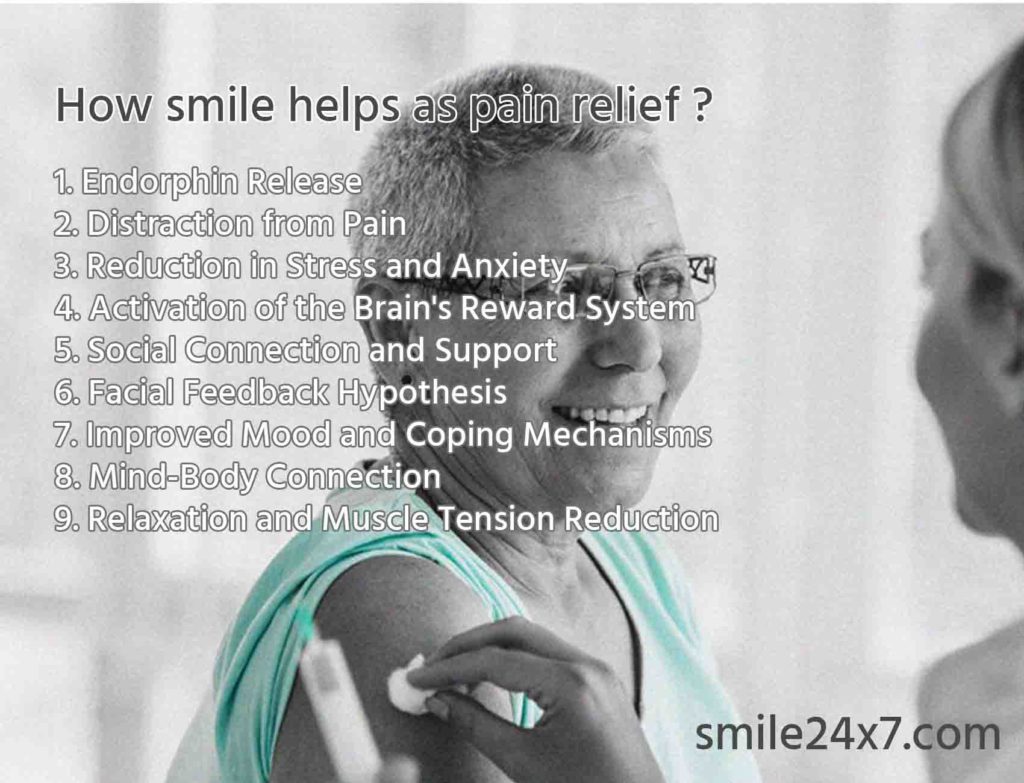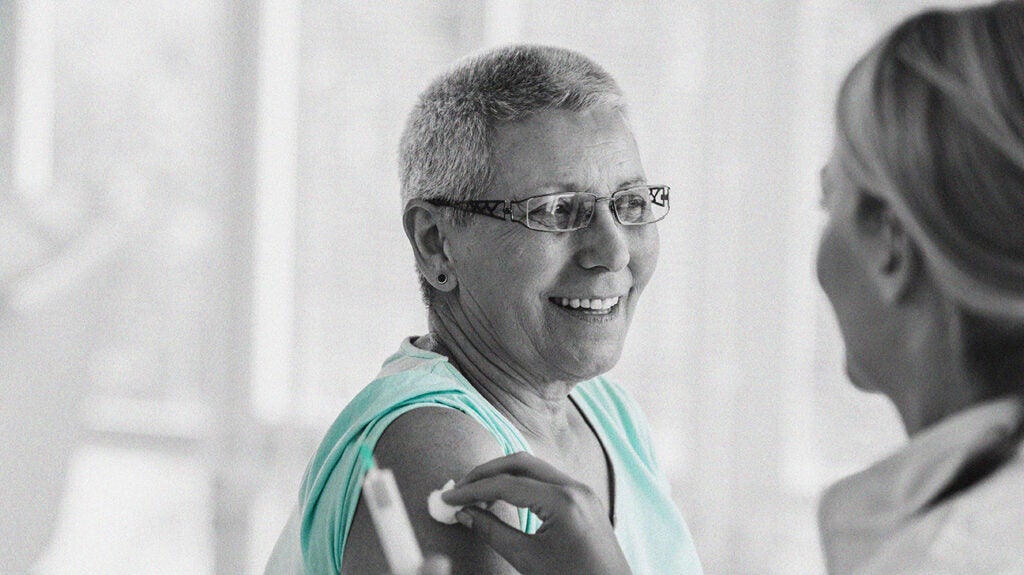Smile can contribute to pain relief through a combination of psychological, neurological, and physiological mechanisms. While it may not replace medical interventions for severe pain, it can complement pain management strategies and promote a sense of well-being.
Here’s how smiling can play a role in pain relief :
1. Endorphin Release :
Smiling triggers the release of endorphins, which are natural painkillers produced by the brain. Endorphins bind to receptors in the brain, reducing the perception of pain and creating a sense of euphoria. The more genuine the smile, the more robust the endorphin release.
2. Distraction from Pain :
When you smile, especially in response to something enjoyable or amusing, your attention is diverted from the pain. This distraction can temporarily shift your focus away from discomfort, providing relief by altering your perception of the pain.
3. Reduction in Stress and Anxiety:
Smiling has been associated with a reduction in stress and anxiety. Chronic pain often exacerbates stress, creating a cycle of heightened discomfort. By promoting relaxation and reducing stress, smiling can indirectly contribute to the alleviation of pain.
4. Activation of the Brain’s Reward System:
Smiling activates the brain’s reward system, including areas like the nucleus accumbens. This activation can modulate the perception of pain and create a positive emotional state, providing a counterbalance to the experience of discomfort.
5. Social Connection and Support:
Sharing a smile in social situations or receiving a smile from others can create a sense of connection and support. Positive social interactions release oxytocin, a hormone that can have analgesic effects and contribute to emotional well-being.
6. Facial Feedback Hypothesis:
According to the facial feedback hypothesis, the physical act of smiling can influence emotional experiences. Smiling sends signals to the brain that may modulate the experience of pain. It’s a two-way interaction between facial expressions and emotional states.
7. Improved Mood and Coping Mechanisms:
Smiling contributes to an improved mood, and a positive emotional state can enhance coping mechanisms. Individuals who maintain a more positive outlook may find it easier to cope with pain, and smiling becomes a tool in their emotional toolbox.
8. Mind-Body Connection:
The mind and body are interconnected. By engaging in a positive behavior like smiling, you create a feedback loop that communicates to the brain a state of well-being. This mind-body connection can influence pain perception.
9. Relaxation and Muscle Tension Reduction:
Smiling often involves the relaxation of facial muscles. This relaxation can extend to other muscle groups, contributing to an overall reduction in muscle tension. In conditions where muscle tension exacerbates pain, this can be beneficial.
It’s important to note that while smiling can offer some relief, it is not a substitute for professional medical care. Individuals experiencing chronic or severe pain should consult with healthcare professionals for appropriate pain management strategies. However, incorporating moments of joy, laughter, and genuine smiles into daily life can contribute positively to overall well-being and may play a role in managing pain perception.
Let’s explore the role of smiling in pain relief through a unique example:
The Laughter Prescription: A Tale of Smiles and Pain Relief
In a whimsical town named Cheerburrow, there lived a quirky group of residents who believed in the magical power of smiles to alleviate pain. Among them was Dr. Grinfellow, a jovial character with a perpetual smile on his face.
One day, a resident named Lily entered Dr. Grinfellow’s clinic, clutching her side in discomfort. Lily was experiencing persistent pain from a recent injury. Dr. Grinfellow, with his infectious grin, prescribed something unusual – a daily dose of laughter.
Lily was skeptical at first but decided to give it a try. She joined a local laughter yoga class where participants engaged in playful exercises and contagious laughter. Each session ended with a smile meditation, where everyone would close their eyes and smile serenely.
To Lily’s surprise, she found herself genuinely laughing and smiling during these sessions. Something remarkable started happening. The more Lily embraced the laughter prescription, the less she noticed her pain. It wasn’t a miraculous cure, but the experience of joy and connection significantly changed her perception of discomfort.
In this playful town, residents believed that laughter and smiling worked like a magical salve. Lily’s daily practice of smiling and laughter became a cornerstone of her pain management routine. It wasn’t just about the physical act; it was about creating a positive mindset that influenced how she experienced pain.
As Lily continued her laughter prescription, she noticed improvements not only in her pain levels but also in her overall well-being. The communal aspect of laughter yoga, with shared smiles and infectious laughter, created a supportive environment that went beyond pain relief—it fostered a sense of community and resilience.
This fictional tale illustrates a unique approach to pain relief through intentional smiling and laughter. While the scenario is fanciful, it highlights the potential of positive emotions, social connection, and the physiological effects of smiling in influencing how individuals perceive and cope with pain.
Let’s explore the unique and imaginative ways in which laughter and smiles contribute to pain relief :
The Chuckle Symphony: A Melody of Pain Relief
Imagine your body as a grand orchestra, and pain as a dissonant note disrupting the harmony. Now, enter the Chuckle Symphony, a fantastical realm where laughter and smiles are the conductors of pain relief.
- Laughter: The Maestro of Endorphins:
- In the Chuckle Symphony, laughter takes the stage as the maestro of endorphins. As the audience (you) erupts in laughter, the orchestra of your body releases an abundance of endorphins, those magical musicians that play a symphony of joy, drowning out the discordant notes of pain.
- Smiles: The Crescendo of Facial Feedback:
- Smiles join the symphony as the crescendo of facial feedback. Each smile sends signals to the orchestra, telling them to play a more uplifting tune. The facial muscles’ dance triggers a positive feedback loop, amplifying the mood and orchestrating a harmony that soothes the pain away.
- Giggles: Tickling the Pain Away:
- Giggles become the mischievous troubadours, tickling pain into submission. Their playful melodies dance through your nerves, creating a delightful distraction that convinces pain to take a temporary bow and exit the stage.
- Belly Laughs: Abdominal Acrobatics:
- Enter the belly laughs, the acrobats of the Chuckle Symphony. With each hearty laugh, they perform somersaults, engaging the abdominal muscles in a joyous workout. These acrobatics not only strengthen your core but also provide a gentle massage, easing tension and discomfort.
- Humor Harmonics: Tuning Your Pain Perception:
- The Humor Harmonics section of the orchestra tunes your pain perception. Humorous thoughts, jokes, and amusing anecdotes act as tuning forks, adjusting your mental frequency. In this tuned state, pain becomes a softer note in the overall composition, losing its sharp edges.
- Comedic Resilience: Weathering the Painstorm:
- In the Chuckle Symphony, laughter is a shield of comedic resilience. As you laugh, you craft a protective barrier, shielding yourself from the onslaught of painstorms. The resilience of humor becomes your armor, allowing you to face discomfort with a lighthearted spirit.
- Shared Guffaws: Building a Joyful Chorus:
- Shared laughter becomes the joyful chorus, uniting you with others in a harmonious bond. The communal experience of laughter creates a supportive environment, where the collective energy of shared joy acts as a balm for everyone’s individual pain.
- Serene Smiles: Healing Elixirs of Serotonin:
- Serene smiles take the spotlight as healing elixirs of serotonin. As you smile serenely, serotonin, the calm-inducing chemical, flows through your system like a soothing river. This gentle current washes away stress, allowing pain to recede into the background.
In this whimsical Chuckle Symphony, laughter and smiles collaborate to create a masterpiece of pain relief. The orchestration of endorphins, facial feedback, ticklish giggles, and the resilience of humor forms a delightful composition that transforms the cacophony of pain into a symphony of joy.

Does smiling really helps as pain relief?
According to the authors, the effect of the induced facial expression was strongest immediately after the injection. They explain that “the Duchenne smile and grimace groups reported approximately 40% less needle pain versus the neutral group.”
When the researchers examined heart rate data, they found that the Duchenne smile group had significantly lower heart rates than the neutral group. There were no significant differences between the other groups.
As for EDA, they only noted marginal benefits in the Duchenne smile group. Overall, the authors conclude:
“Together, these findings indicate that both smiling and grimacing can improve subjective needle pain experiences, but Duchenne smiling may be better suited for blunting the stress-induced physiological responses of the body versus other facial expressions.”
(reference)





